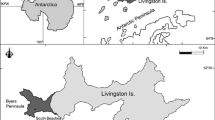Abstract
Small ponds and puddles are extremely common throughout the ice-free areas of the maritime Antarctic. The carbon and nitrogen dynamics in a typical pond on Livingston Island, South Shetland Islands were investigated during summer 1991. The pond vegetation consisted of a benthic mat of cyanobacteria, diatoms and chlorophytes. The mat was not limited by nutrient availability, both phosphorus and nitrogen being available in the overlying water and N:P ratios in both the water and the mat indicating a roughly balanced supply. Maximal rates of carbon fixation of 0.1–0.2 mgC g−1 dry weight h−1 were similar to those of other perennial Antarctic mat communities. Productivity appeared to be limited by physical factors, but the effects of irradiance and temperature could not be separated. Although carbon fixation rates were low, carbon loss processes were minimal leading to an accumulation of material in the mat approximating to one doubling per year. Atmospheric nitrogen fixation was not a significant component of the nitrogen budget of the pond, accounting for only 0.1 % of the nitrogen accumulation by the mat. Nitrogen uptake was largely from dissolved nitrogen sources, in particular as dissolved organic nitrogen. It is concluded that ephemeral water bodies may play a significant role in the nutrient dynamics of maritime Antarctic ecosystems.
Similar content being viewed by others
References
Barrie, A., 1991. New methodologies in stable isotope analysis. In International Atomic Energy Agency, Stable isotopes in plant nutrition, soil fertility and environmental studies. Proceedings of an international symposium. International Atomic Energy Agency, Vienna: 3–25.
Davey, M. C., 1991. The seasonal periodicity of algae on Antarctic fellfield soils. Holarct. Ecol 14: 112–120.
Davey, M. C. & K. J. Clarke, 1992. Fine structure of a terrestrial cyanobacterial mat from Antarct. J. Phycol. 28: 199–202.
Davey M. C., J. Pickup & W. Block, 1992. Temperature variation and its biological significance in fellfield habitats on a maritime Antarctic island. Antarctic Sci. 4: 383–388.
Eisenreich, S. J., R. T. Bannerman & D. E. Armstrong, 1975. A simplified phosphorus analysis technique. Envir. Letters 9: 43–53.
Hawes, I., 1989. Filamentous green algae in freshwater streams on Signy Island, Antarctica. In W. F. Vincent & J. C. Ellis-Evans (eds), High Latitude Limnology. Developments in Hydrobiology 49. Kluwer Academic Publishers, Dordrecht: 1–18. Reprinted from Hydrobiologia 172
Hawes, I., 1990. Eutrophication and vegetation development in maritime Antarctic lakes. In K. R. Kerry & G. Hempel (eds), Antarctic Ecosystems. Ecological Change and Conservation. Springer-Verlag, Berlin: 83–90.
Hawes, I. & P. Brazier 1991. Freshwater stream ecosystems of James Ross Island Antarctica. Antarct. Sci. 3: 265–271.
Hecky, R. E. & P. Kilham, 1988. Nutrient limitation of phytoplankton in freshwater and marine environments: a review of recent evidence on the effects of enrichment. Limnol. Oceanogr. 33: 796–822.
Howard-Williams, C., J. C. Priscu & W. F. Vincent, 1989. Nitrogen dynamics in two Antarctic streams. In W. F. Vincent & J. C. Ellis-Evans (eds), High Latitude Limnology. Developments in Hydrobiology 49. Kluwer Academic Publishers, Dordrecht: 51–61. Reprinted from Hydrobiologia 172
Mackereth, F. J. H., J. Heron & J. F. Talling, 1978. Water analysis: some revised methods for limnologists. Freshwater Biological Association Scientific Publications No. 36. 120 pp.
Marker, A. F. H., C. A. Crowther & R. J. M. Gunn, 1980. Methanol and acetone as solvents for estimating chlorophylla and phaeopigments by spectrophotometry. Ergeb. Limnol. 14: 88–90.
Nutting, P., 1943. Some standard thermal dehydration curves of minerals. U.S. Geol. Surv. Profess. Paper 197-E.
Priddle, J., 1985. Terrestrial habitats — Inland waters. In W. N. Bonner & D. W. H. Walton (eds), Key Environments Antarctica. Pergamon Press, Oxford: 118–132.
Reynolds, C. S., 1984. The ecology of freshwater phytoplankton. Cambridge University Press, Cambridge. 384 pp.
Smith, R. I. L., 1988. Recording bryophyte microclimate in remote and severe environments. In J. M. Glime (ed.), Methods in Bryology. Proceedings of the Bryological Methods Workshop. Hattori Botanical Laboratory, Mainz, Nichinan: 275–284.
Talling, J. F., A. F. H. Marker & P. Toms, 1978. Chlorophyll content. In Department of the Environment, Analysis of raw, potable and waste waters. HMSO, London.
Tett, P., S. I. Heaney & M. R. Droop, 1985. The Redfield ratio and phytoplankton growth rate. J. mar. biol. Ass. UK 65:487–504.
Vincent, W. F., 1988. Microbial systems of Antarctica. Cambridge University Press, Cambridge. 304 pp.
Author information
Authors and Affiliations
Rights and permissions
About this article
Cite this article
Davey, M.C. Carbon and nitrogen dynamics in a small pond in the maritime Antarctic. Hydrobiologia 257, 165–175 (1993). https://doi.org/10.1007/BF00765009
Received:
Revised:
Accepted:
Issue Date:
DOI: https://doi.org/10.1007/BF00765009




